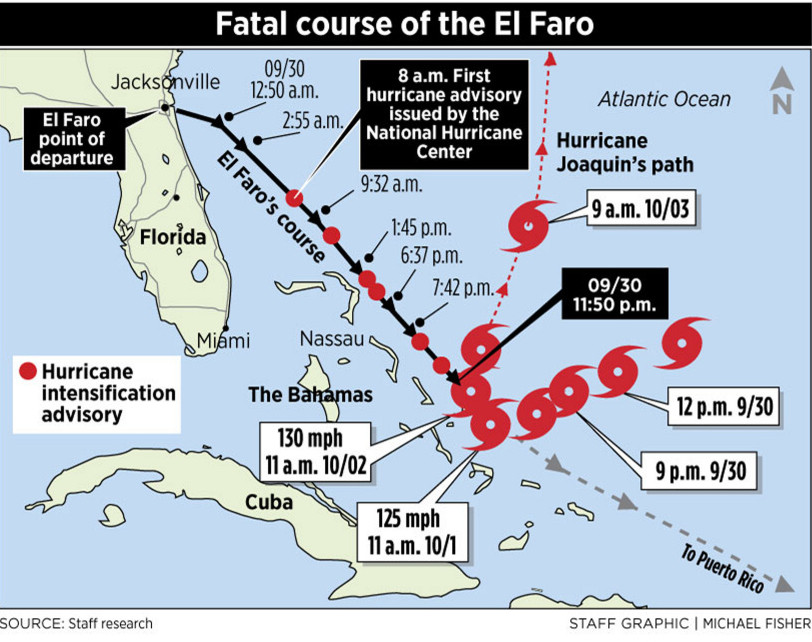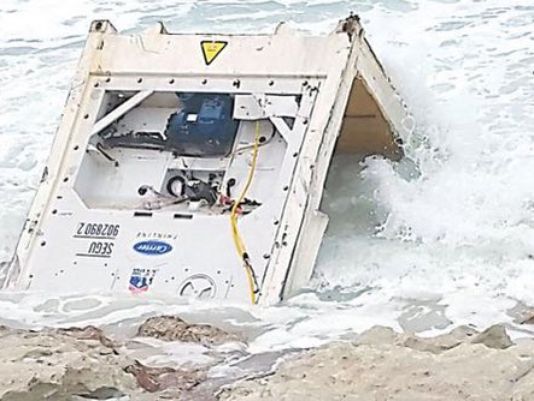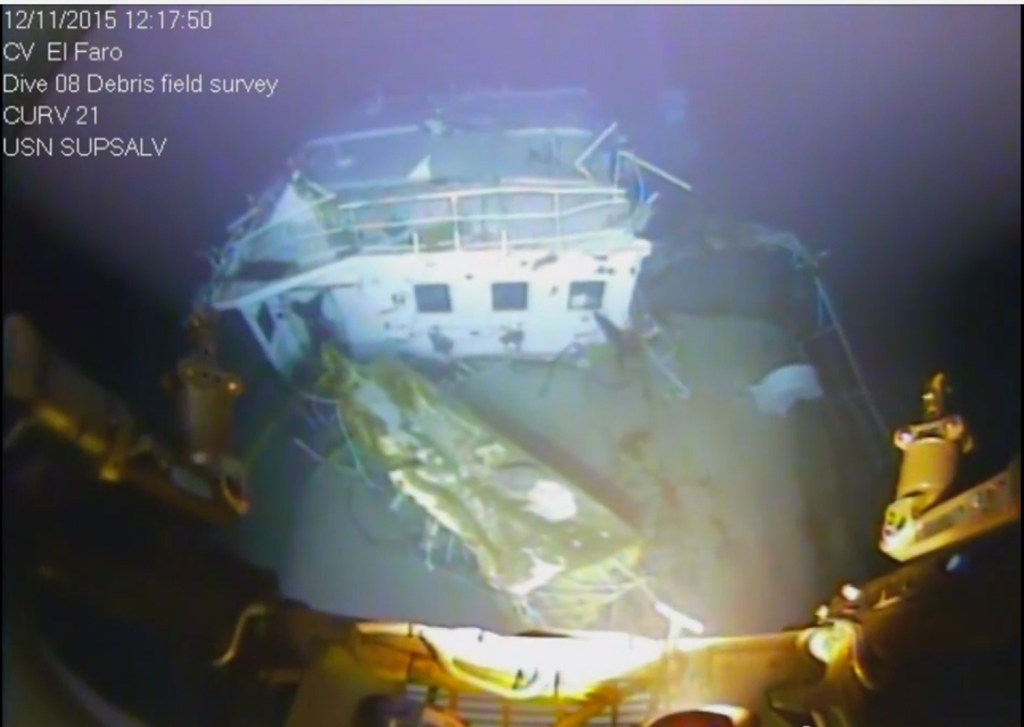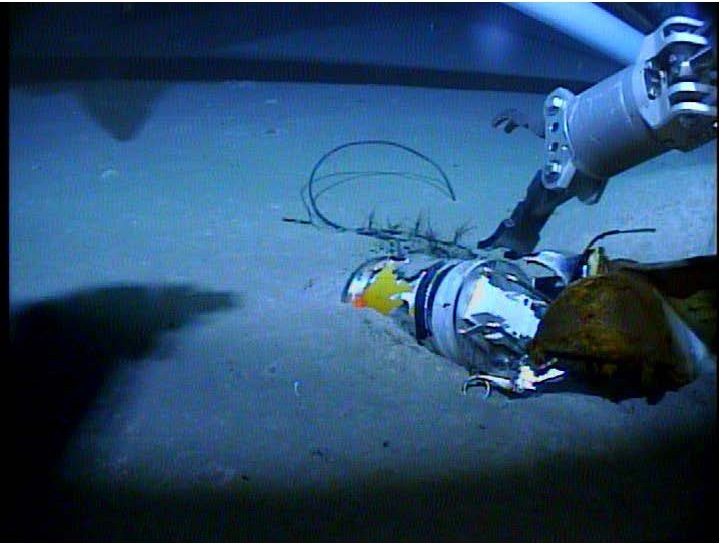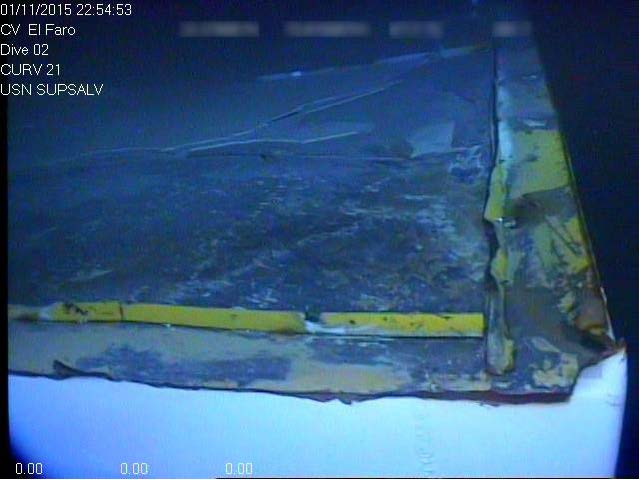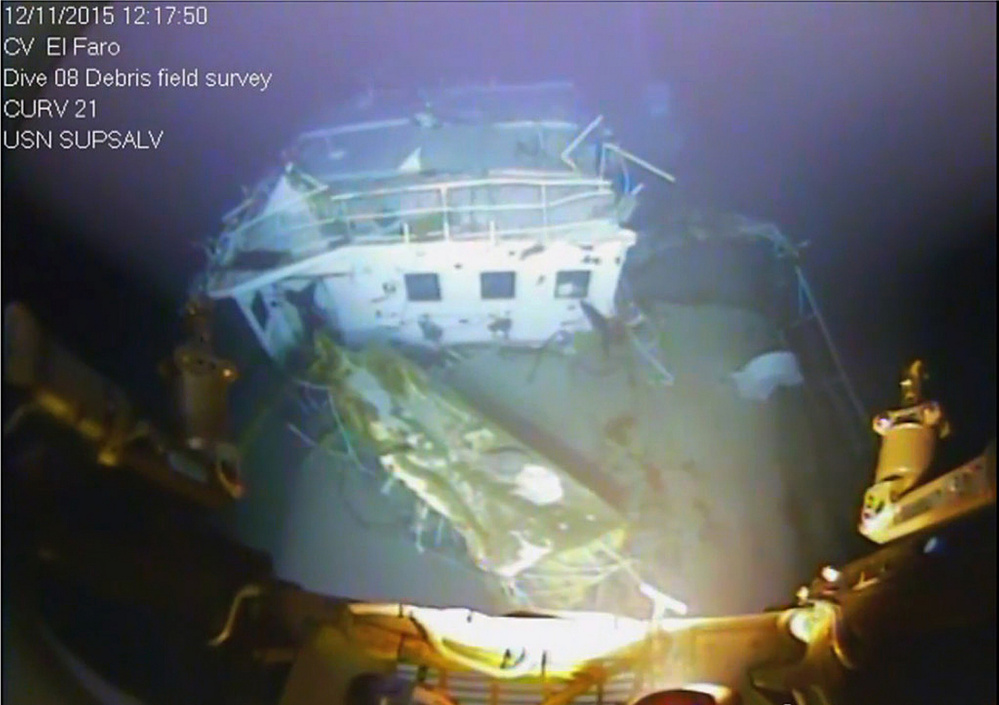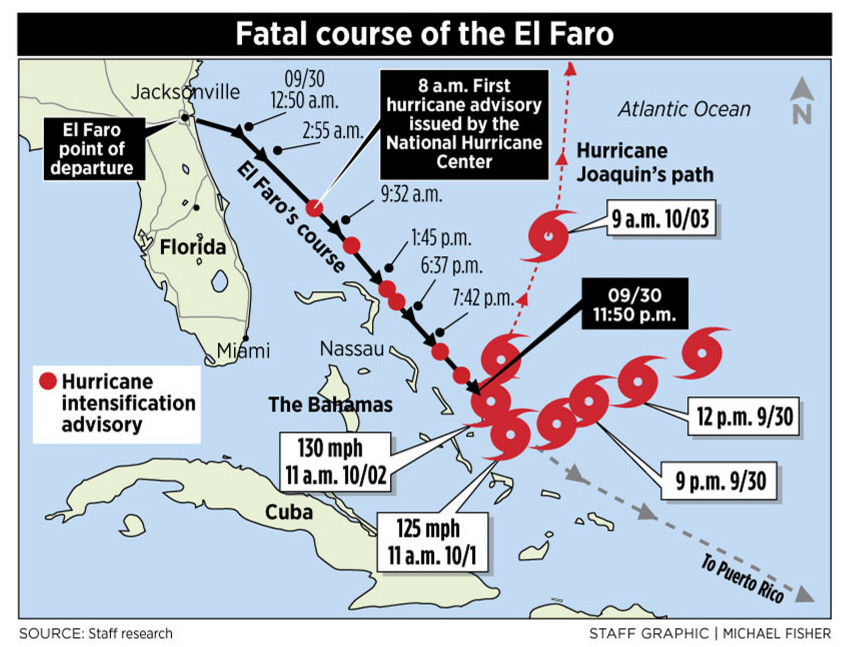The captain of the El Faro rejected suggestions from his second and third mates to alter course as the cargo ship neared a powerful hurricane and the Puerto Rico-bound vessel ended up in the path of the storm, which engulfed the ship and killed all 33 on board.
Transcripts of conversations on the bridge of the El Faro, released Tuesday by the National Transportation Safety Board, show that Capt. Michael Davidson of Windham was convinced his course would take him to the southwest quarter of Hurricane Joaquin as the El Faro headed from Jacksonville, Florida, to San Juan, Puerto Rico, in late September 2015. On that side of the storm, the wind and high seas would be at the rear of the ship, speeding the El Faro away from the hurricane’s eye and the most extreme wind and waves.
But the storm instead moved into the path of the ship, leaving the El Faro northwest of the storm’s center, where it lost propulsion and was hit by winds gusting to 110 mph. Battered by high seas for hours, the ship sank 22 miles north-northwest of the eye of the storm on Oct. 1, 2015. The death toll made it one of the worst maritime disasters in recent years.
NTSB officials said Tuesday that some of the weather reports the crew was working with were outdated. Information from the National Hurricane Center, for instance, was six hours old by the time the El Faro got it, and some weather information had to be plotted by hand, further delaying efforts to track the path of the storm related to the ship’s course.
The transcripts, which cover the last 14 hours of the El Faro’s voyage, show a captain and crew increasingly concerned by the storm’s intensity as they dealt with flooding in a cargo hold – causing cars to bob in the water, prompting dark humor references to submarines – and the loss of propulsion. Davidson finally issued a hasty order to abandon ship, then assured a frantic crew member that he would stay with him, pleading with the unidentified crew member to summon the strength to escape the sinking vessel.
The transcripts are from the voyage data recorder recovered last summer from the wreck of the ship in 15,000 feet of water.
Among the dead were Davidson and four other alumni of Maine Maritime Academy: Michael Holland, 25, of Wilton; Danielle Randolph, 34, and Dylan Meklin, 23, both of Rockland; and Mitchell Kuflik, 26, of Brooklyn, New York.
PRAISE FOR CREW’S PROFESSIONALISM
Deb Roberts, Holland’s mother, said she read through part of the transcript Tuesday and was impressed by the crew’s professionalism and attempts to keep the ship afloat until the end.
“They never gave up” on the ship or each other, she said.
Although no one is referred to by name in the transcript, Roberts said it’s unlikely her son’s voice was recorded. As one of three engineers aboard the ship, he would have been in the engine room, dealing with the faltering engine, while those on the bridge struggled more directly with the storm. The transcripts include calls between the bridge and the engineers, but only reference the side of the conversation conducted by those on the bridge. There were six microphones around the bridge that picked up conversations there.
“What was most striking was the professionalism” of the crew, Roberts said. “They worked their asses off and never gave up on each other. That makes me so proud as a mom.”
Roberts understands that many will read the transcripts with an eye toward pointing fingers and assessing blame, but she encouraged people to give the NTSB time to complete its analysis of the disaster.
“It’s so hard. People are trying to pass judgment, but let them do their job,” she said.
STAYING COURSE, VIEW OF RETIRED MARINER
The transcripts show that a little more than eight hours before the ship was lost, a third mate on watch on the bridge called Davidson to tell him that the latest weather reports had grown more ominous. He asked if Davidson wanted to plot a more southerly course for the El Faro. Davidson’s response was not captured on the recording, but the third mate tells other crew members that the captain had said to stick to his course.
Around 2 a.m., the second mate also called Davidson in his cabin to ask if the course should be changed. Again, the second mate related to others on the bridge that the orders were to stay on course.
The crew’s calls, as well as the captain’s decision not to change course, are not unusual, said Laurence Wade, a former merchant mariner who was master of Maine Maritime Academy’s training ship.
Wade, now retired, said most captains leave a written night order for the overnight crew, telling members what course to follow and saying they should call him in his cabin with questions or concerns.
“It’s not unusual at all to get woken up several times in a night,” Wade said.
Neither was it surprising that Davidson wanted to stick to his course, Wade said.
“The southwest quadrant (of a hurricane) is where you want to be,” he said. “When you’re running downwind, you’re not heading into the wind and the seas.”
The El Faro and other ships of its type are relatively fast and considered solid ships, Wade said, leading the captain to believe he could make it past the hurricane. But reports that it was taking on water and listing heavily were signs of serious problems, Wade said.
“A 2 percent list, you worry about,” he said. “But a 15 percent list (which the El Faro reported) is pretty near impossible.”
The NTSB released the transcripts, along with reports on the ship’s equipment and weather updates, with little comment. Officials said the investigation is continuing and the full final report will outline the reasons the ship sank, along with steps that should be taken to avoid similar disasters in the future.
In a statement to the Associated Press, Tote Maritime, the owner of the ship, denied having any say over Davidson’s voyage planning, saying that was left up to him.
“Our crews are trained to deal with unfolding weather situations and are prepared to respond to emerging situations while at sea,” the company said.
The transcript refers to loud sounds heard in the background of the bridge conversations. NTSB officials said that was likely cargo containers shifting and banging around the ship’s hold, as well as parts of the ship’s structure coming apart. Near the end of the transcript there’s a reference to a “building low-frequency rumble” that lasts until the end of the recording at 7:40 a.m. on Oct. 1.
YELLING NEAR END OF THE RECORDING
At the news conference Tuesday morning, NTSB officials repeatedly declined to characterize the behavior of the crew members, saying that was part of the ongoing investigation. The transcript refers to yelling, especially near the end of the recording, and at one point the transcript says Davidson angrily ordered that the full crew be woken up as the ship took on water. He sounded a general alarm before ordering the crew to abandon ship.
Federal law bars release of the actual audio recording.
“To the extent that we can make a determination about the mood in the moment, that will be part of the analysis,” said Christopher Hart, chair of the NTSB. “To the extent that we can reliably do that, we will do that in the analysis.”
Two separate investigative hearings have been held into the El Faro tragedy – one in February and the other in May. A third is likely. So far, investigators have focused on factual information about weather reports, the ship’s condition and decisions made by the captain.
In May, the lead investigator with the NTSB called the sinking a “colossal failure of management,” and former crew members have testified that they questioned the seaworthiness of the 41-year-old ship.
Send questions/comments to the editors.




